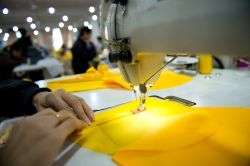Copycat designers poised to pounce on Paris fashion

See it in the shops in a month’s time. When the ready-to-wear shows start in Paris on Tuesday, teams of designers for high street stores will be poised to spring into action.
Thanks to their efforts, strikingly similar mass market versions of the latest designer outfits will be in the shops within weeks — and at a fraction of the price.
Some call it ‘taking inspiration’. For others it is copying or ripping designers’ work off. Nearly everyone agrees it is pervasive and that there is very little the industry’s top talents can do about it.
Nine days of ready-to-wear fashion shows begin in Paris on Tuesday with collections by nearly 100 labels for spring/summer 2015.
But before the catwalk models have even kicked off their high heels, designers for big-name retailers will be poring over the pictures on the Internet and homing in on the trendiest looks.
In some companies, specialist pattern cutters and tailors will be on standby ready to “whip something up literally within 24 hours”, according to Jane Banyai, of the British designers’ trade organisation ACID.
In the 1950s, copies of Paris Match magazine with images from fashion shows appeared covered in thick black lines to prevent the designs being copied.
Fashion shows then were exclusive affairs at which only a few privileged invitees were lucky enough to get a glimpse of the next season’s trends.
Today, designers have far less control and pictures from the shows can be zinging their way around the world within seconds with just a few clicks of a smartphone.
“It’s terribly easy for things to be reproduced. A photograph can be out in Asia within seconds and they can be in production within minutes,” Banyai told AFP.
– ‘Comparison shopping’ –
With so many imitation garments in circulation, fashion magazines delight in showing their readers pricey designer pieces and high street versions with more modest price tags.
Kal Raustiala, a law professor at UCLA and co-author of the book “The Knockoff Economy” said the practice was so widespread that most designers felt powerless to stop it.
“Knock-offs are everywhere. They’re almost an accepted part of the reality of this world,” he told AFP.
Raustiala said he became interested in the subject after a friend who worked in fashion told him about a “comparison shopping” trip he had been on to London.
“I think there are different phrases used but what he was doing was going around London looking at clothes, taking pictures and bringing things back to copy,” he said.
“I was surprised to find out that it was legal and that it was common practice,” he said, adding that he believed it was the legality rather than the Internet that was responsible for “accelerating and turbocharging” copycat fashion.
Michael Chan, a New York-based intellectual property lawyer, said he usually advised clients not to go to court.
“If it’s a question of ‘I have a particular leopard print pattern’ and someone else makes a slightly different one — well, the cycle is too fast to do anything,” he said.
“I would not advise clients to go after it. They might, but you’re probably just taking resources away from your business.”
“Unless you have some particular reason you want to do it, you just have to let it go,” he said.
– Flattery –
Designers do sue sometimes. Yves Saint Laurent famously sued Ralph Lauren for copying a tuxedo dress from his 1992/3 couture collection and won.
More recently, in 2007, British store Topshop had to bin over 1,000 dungaree-look yellow minidresses after losing a copyright case brought by the Chloe fashion house.
Topshop boss Philip Green at the time utterly refuted that the dress was a copy.
But he said the company agreed to pay £12,000 ($19,500, 15,100 euros) in compensation plus legal costs in order to avoid a protracted legal wrangle and “get on with the rest of our lives”.
Banyai said most big brands were too busy with the next season to care about who may or may not have copied them last season, but that it was more of an issue for smaller designers.
“There’s a real dichotomy between the small players and the big players. For the small ones whether you sell a particular range can be the bread and butter on your table.
“For the big ones, they have another three collections that year to worry about and so they don’t seem to be so concerned about it. They see it as flattery,” she said.
All acknowledge, however, that copying is far from a new problem.
“You can go back to the great depression and there are accounts of how within 24 hours dresses are being copied,” Raustiala added.
“In the 1930s they would just steal a sketch from the art boy.”
har /gj/ns

